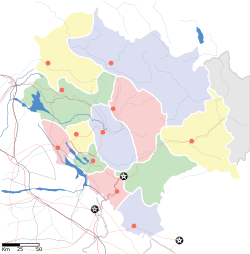Jawalamukhi
|
Jawalamukhi Jawalaji |
|
|---|---|
| city | |
 |
|
| Location in Himachal Pradesh, India | |
| Coordinates: 31°53′N 76°19′E / 31.88°N 76.32°ECoordinates: 31°53′N 76°19′E / 31.88°N 76.32°E | |
| Country |
|
| State | Himachal Pradesh |
| District | Kangra |
| Elevation | 610 m (2,000 ft) |
| Population (2001) | |
| • Total | 4,931 |
| Languages | |
| • Official | Hindi |
| Time zone | IST (UTC+5:30) |
Jawalamukhi is a town and a nagar parishad in Kangra district in the Indian state of Himachal Pradesh.
Jawalamukhi is located at 31°53′N 76°19′E / 31.88°N 76.32°E. It has an average elevation of 610 metres (2,001 feet).
At the 2001 India census, Jawalamukhi had a population of 4931. Males constitute 52% of the population and females 48%.
As of 2001[update] India census,
Jwalamukhi is a famous temple to the goddess Jwalamukhi, the deity of flaming mouth. Raja Bhumi Chand of Kangra, a great devotee of goddess Durga, dreamt of the sacred place and the Raja set people to find out the whereabouts of the site. The site was traced and the Raja built a temple at that location. The building is modern with a gilt dome and pinnacles, and possesses a beautiful folding door of silver plates. Under the gaze of the Dhauladhar range and set amidst the undulating hills that character sub-Himalayan Himachal Sati's tongue is believed to have fallen at Jwalamukhi and the goddess is manifest as tiny flames that burn a flawless blue through fissures in the age old rock.
Western scholars and scientists have made several expeditions to repel the Devine belief but have till date been unsuccessful to show any presence of natural gas reserve justifying theories of natural gas powering the flames. On the contrary local inscriptions show the age old existence of divine power.
The temple located on a small spur on the Dharamsala-Shimla road at a distance of about 20 km from the Jwalamukhi Road Railway Station attracts hundreds of thousands of pilgrims every year. No idol is located in the temple and the deity is worshipped in the form of flames which come out from the crevices of the rock. There is a small platform in front of the temple and a (check usage) big mandap where a huge brass bell presented by the King of Nepal is hung. Usually milk and water are offered and the ahutis or oblations are offered to the sacred flames in the pit, situated in the centre of the temple in between the floor pillars supporting the roof.
...
Wikipedia


